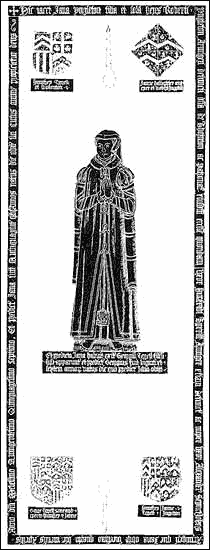
Jane Ingleton MSII 1557
Upper sinister marginal inscription is palimpsest, also inscription under figure. See note

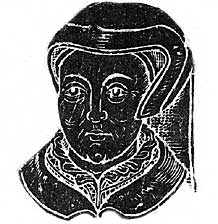
Rubbing of the head showing Paris headress

Rubbing of the hands showing the rings and cuffs
 shield 1: Humfrey Tyrell of Wokenton |
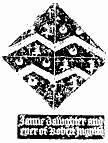 losenge Jane Ingleton daughter and eyer of Robert Inglyton |
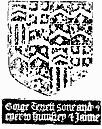 shield 2: Gorge Tyrell son and eyer to Humfrey & Jane |
 shield 3: Humfrey | Jane Tyrell | Inglyton |
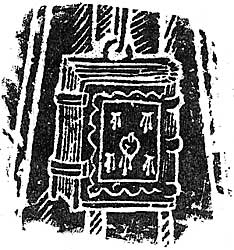
Rubbing showing the Book of Hours
 |
|
|
|
|
 |
|
|
Lower inscription palimpsest. Made from four pieces of (reused) metal |
|
|
|
|
|
Palimpsest discovered and repaired 16/12/97 by B. Egan. |
Date recorded: 2 May 2002.
Description: Standing figure of woman in close cap, long coat with hanging sleeves, and girdle pendant to which is attached a small clasped book, with the Five Wounds stamped on the cover. An inscription plate under her feet, three shields and a lozenge of arms, each with a small inscription below, all enclosed within a marginal inscription. It was originally on a chest tomb, but since Willis does not describe this, it must have been quite plain.
Style: London 'Lytcot'. (post Fermour) script style - Fermour
Inscription:
|
Margin: Hic iacet Jana Yngleton filia et sola heres Roberti / Yngleton Armigeri defuncti d(omi)na de Thornton ac Patronat(a) eiusd(e)m eccl(es)ie quondam uxor Humfridi Tyrrill Armiger(i) etiam defunct(i) ac nuper uxor Alexander SeynctJohns / Armigeri que Jana obiit vicesimo quarto die mensis Aprilis / Anno d(omi)ni Melesimo Quingentesimo Quinquagesimi Septimo, Et predict(a) Jana fuit Quinquagint(a) qui(n)q(ue)a Annos natus die obit(us) sui Cuius Anime propicietur deus. Foot: Et predicta Jana habuit exit(um) Georgiu(m) Terrell filiu(m) / suu(m) apparunt(um) et predict(us) Georgius fuit viginti et / septem annor(um) natus die quo predict(a) Jana obiit. a written qitqe. |
Interpreted:
|
Here lies Jane Ingleton, daughter and sole heiress of Robert Ingleton, esquire, deceased, Lady of Thornton and patroness of this church; she was once wife of Humphrey Tyrrell, esquire, also deceased, and more recently wife of Alexander StJohn, esquire, the which Jane died 24 April 1557, and the said Jane was 55 years old on the day of her death; may God have mercy on her soul; and the said Jane had issue George Tyrrell, her manifest son, and the said George was twenty seven years old on the day when the said Jane died. |
Script: Gothic minuscule 'script 6'.
Heraldry: I: Quarterly: i, Argent, two chevrons azure within a bordure engrailed gules, TYRRELL, ii, Argent, a cross between four escallops sable, COGGESHALL, iii, Paly of six argent and sable, SWINFORD, iv, Gules, on a chevron engrailed argent three dolphins haurient vert, FLAMBERT. Underneath: Humfrey Tyrrell / of Wokenton.
II (lozenge): Quarterly, i and iv, Argent, semy of crosslets fitchy azure, a chevron sable between three gryphons' heads erased azure, INGLETON, ii and iii, Argent, a chevron between three crescents sable flamant gules, also for INGLETON. Underneath, Janne Dawghter and / eyer of Robert Ingylto(n).
III: Quarterings of TYRRELL as no I, quartering quarterings of INGLETON as no II. Underneath, George Terrell Sone and / eyer to Humfrey & Janne.
IV: Quarterings of TYRRELL as no I, impaling quarterings of INGLETON as no II. Underneath, Humfrey Terrell / Janne Ingylton.
Slab type: Grey Unio Purbeck marble.
Dimensions: Figure 77 x 24 cm, foot inscr. 8 x 43 cm, marg. inscr. 1.89 x 0.68 m, 35 mm wide, shields 16 x 14 cm, lozenge 19 x 19 cm, small inscrs. 4 x 15 and 4 x 17 cm; slab 2.61 x 0.86 m.
Previous uses: The slab has five or six visible cemented-in rivet holes, of which one certainly and the other possibly has a long channel leading from it, implying a previous use for fixing a brass of some sort, though no obvious pattern emerges: the slab may have been cut down. Of the brass plates, the foot inscription and the upper part of the sinister fillet of the marginal inscription have been examined, and have previous engraving on the back. The foot inscription is made up of four fragments: 1, fine Gothic minuscule of c. 1480, Perpetuis annis : Norwych miserere ioh(ann)is / Mater dei Memento Mei. (In eternal years, have mercy on John Norwich; Mother of God, remember me.) 2, Upper half of a line of competent Gothic minuscule, c. 1500: [pr]ay for the soule of Johan Pome which died the ...; 3, Fragment of Gothic minuscule, early 16th century: [... Cris]toffer co(n)fra[ter...] / [... propi]ciet(ur) de(us) am[en.] (... brother Christopher ... God have mercy Amen ...) 4, Fragment of similar script, Will(ia)m p... The marginal strip is of very fine raised Gothic minuscule 'script 4', which is dated 1530-47, beginning with a boar's head: The best songe that I canne is requiem eternam, part of a well known verse epitaph of which examples survive at Northleach, Glos., and Royston, Herts, both c. 1490-1500. Lost examples are quoted by Haines.
Notes: Jane was nine months old on the death of her father Robert in 1503 (when he himself was still a minor); her mother Ann was the daughter of Sir Richard Empson, who was Robert's guardian; after Robert's death Ann and her new husband John Hugford attempted to sue the Ingleton estate in Chancery, whereupon Jane was removed from her custody and placed under the wardship of Dame Joan Bradbury, widow. She married Humphrey Tyrrell in 1517 (being then aged 14) and after his death in 1549 married Alexander St John. The palimpsests were recovered in 1984 and 1997 by B.S.H.E.
References: Mill Stephenson, II; L.S.W. Bucks., 212-3; Lipscomb, Bucks., III, 118-22; V.C.H. Bucks., IV, 245; H. Haines, Manual of Monumental Brasses, (1860), p. clxxxi; R.H. Russell, 'The Monuments at Thornton, Bucks.' in Records of Bucks., VII, 52-60; Page-Phillips, Palimpsests 3rd addenda (1986) p. xvii and pl. 195.
References: Mill Stephenson, II; L.S.W. Bucks., 212-3; Lipscomb, Bucks., III, 118-22; V.C.H. Bucks., IV, 245; H. Haines, Manual of Monumental Brasses, (1860), p. clxxxi; R.H. Russell, 'The Monuments at Thornton, Bucks.' in Records of Bucks., VII, 52-60; Page-Phillips, Palimpsests 3rd addenda (1986) p. xvii and pl. 195.
5th January 1998
Your piece of inscription is part of a verse epitaph which you can find complete at Northleach, Glous., (M.S.IV) and Royston, Herts, (M.S.IV), both undated but c.1490 -1500. Haines (p. clxxxi) quotes lost examples at Baldock, Herts 1483, Maldon, Essex, undated, Romford, Essex, 1480 and St Martin's Ludgate Hill, undated, from Weaver (pp. 545, 610, 649 and 387), and Douglas Gray cites a seventh lost example from st Michael's Crooked Lane, London, for John Shrow, stockfishmonger 1487, from Stow, Survey of London p. 175 ("A Middle English Epitaph" in Notes & Queries, New Series 8, 132-5 (April 1961)). The epitaph is only the last stanza of a much longer poem found in MS Balliol 354 and printed in Mediaeval English Lyrics, ed. by RT. Davies, 1963, no. 109 (p. 206-7).
Farewell my frendes, the tyde abideth no man
I am departed from hense and so shall ye,
But in this passage the best songe that I can
Is requiem eternam now : Jesu graunte it me,
Whan I have ended all myn adversite,
Graunte me in paradise to have a mansion,
That shed thy blode for my redemcion.
Your fragment seems to be later than any of the dated ones hitherto known, as it is in John Page-Phillips’ “script 4” which flourished 1530 -1547. It may be monastic spoil, in which case date it 1530 - 39, or a workshop waster, which had been lying around for ten years before re-use. Can you tell from the condition of the metal if it had ever been used? It certainly looks very sharp and new on the rubbing. Presumably the rest of the verses are on the back of the remainder of the Thornton marginal lnscription, if you can manage to lift it. I am sure I have seen that little boar's head stop somewhere before, but I can’t place it.
(I think that the boar's head might be of the Warwick family.)